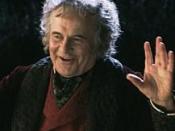Many books have a central theme that can mask smaller implied ideas and subjects. JRR Tolkien's books typically include a main story as well as secondary tales and a singular idea that cover smaller implied concepts. The Hobbit wavers very little from Tolkien's style. The Hobbit, by JRR Tolkien is a journey through maturation, through psyche, and through Middle-Earth.
In "The Hobbit" one is lead through the progression of maturation, and development of the main character, Bilbo Baggins. In the beginning of the story, Bilbo is a person afraid to traverse across the boundaries of his comfort zones, or his hobbit hole and the Shire. Day says that Bilbo's personality is out of balance and far from integrated. His masculinity, or his Tookish aggressiveness, is being repressed so that he is clinging rather immaturely to a childish way of life (42). He is a lover of pleasure, as are most of the rest of his race.
This could be compared to people who are afraid to step out and make a difference in the world. People, like Bilbo, are often afraid to do anything at which they might fail. Gandalf, a wise old wizard, pulls Bilbo away from his seclusion from the world and opens Bilbo's eyes, helping him realize the miserable state in which he is living. Once Bilbo sees the challenges and what fun can be had outside his familiar bubble, he longs more and more to leave his home. As his adventures progress, so does his self confidence. His Baggins impulses are beginning to be counter-balanced, thus bringing about a desirable psychic tension, which can result only when a balance of opposites exists (Matthews 66). Bilbo eventually takes responsibility for the company of dwarves and becomes a productive Hobbit, helping and saving others. After accidentally finding...


